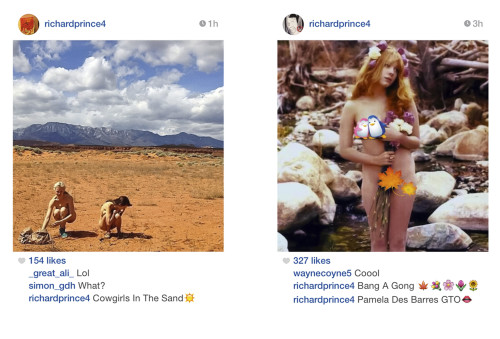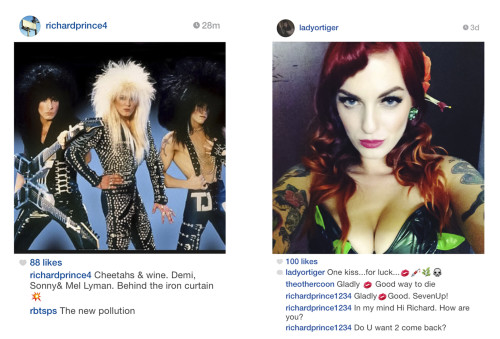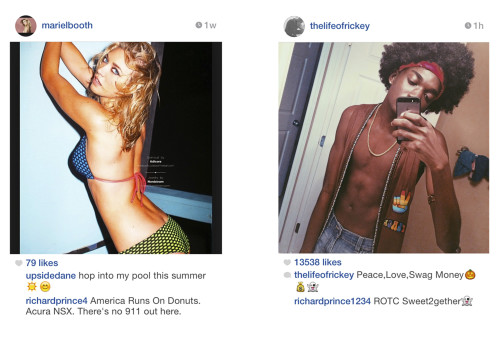Image above: Portrait by Terry Richardson.
STEVE MILLER: Social media is the new cultural medium from which it seems natural to make art. Is it that simple that you came to this medium?
RICHARD PRINCE: Not sure I came to the medium. The medium came to me. And I think “natural” is the perfect word to describe whatever you want to call it.
SM: John McWhinnie wrote one of the clearest essays about your work in the Paris show organized by Bob Rubin, American Prayer. In commenting about some of your earlier photo work John McWhinnie noted their ordinariness or more specifically, “their normality is a special effect”. What I think he was getting after was that in their deceptively simple and believable presentations the “Pictures... look real but have no chance of being real.” In fact, they are re-created with manipulated interventions which we embrace because the created fiction feels more real than the real.
RP: “Normality as the next special effect” was a sentence I used to describe what I was doing in the late seventies. I’ve always liked it when something “way out” is presented in an orderly fashion. When the man who fell to earth really did fall to earth. Micheal Rene and David Bowie. (The Day The Earth Stood Still. And the Man Who Fell To Earth). They were cast as aliens but their physical “appearance” wasn’t altered. They didn’t need make-up. They were just enough. They didn’t need a third eye. They were slightly unhinged to begin with. What’s real is that they’re already too good to be true.
SM: In this spirit, You have called some of your photos “extra-ordinary.” This seems the spirit of the Ins- tagram work. The sheer number of images makes them ordinary and your final re-presentation looks “nor- mal” to the unseasoned eye. However, as the artist (art director,) you edit, condense and annotate the text.
RP: My contribution. That’s what was important. It wasn’t much but it was enough. “Commenting” on, (and IN) someone’s Instagram, was as good as painting their portrait.

SM: None the less, the Instagram images were created by the people who post them. It’s their rep- resentations of themselves but you subtly re-create a new narrative. For the viewer, at first glance, it just looks like the world as we know it. What were you thinking in doing this seemingly modest shift through editing?
RP: My involvement started out innocently. I was on the phone with Jessica Hart and looking at her Instagram “feed” at the same time. I stopped at one of her posts and said to her... “someone should do your portrait with this picture you posted of yourself”. She said, “why don’t you do it?”
SM: Of course both art and advertising are manipulated images. Desire and projection is a compo- nent of both. This strikes me as true of the Instagram images yet, the authors are (for the most part) neither artists nor advertisers (but, no doubt, advertising themselves.) What completes this daisy chain for me is that you are complicit, in that your editing the text is as staged as their original source presentations. We as the audience, complete the work as we consume it on your Instagram feed or in the gallery. Can anyone escape this cycle? (consuming deception)
RP: Instead of escaping... I think it’s a matter of joining. Participating. Sharing. By now, if your not “on the gram” your either in deep shit, quicksand or riding around in a covered wagon.
SM: Speaking of escaping this cycle, when I was in front of the actual paintings, the images seem huge. Especially, because we are used to seeing them on a mobile device. The size feels like a direct “ in your face” experience from which I cannot escape. Removed from the phone they act like paintings. In their editing, they feel like film. Your text commentary even becomes a traditional painting “signature” at the bottom. New media creates new hybrids and strictly speaking these are pigment on canvas and many artist before you have used inkjet on canvas. However, in viewing the work, I found a direct experience about contemporary culture rather than as a painted object (that references history.) So in your modest means, the maximum amount of cultural message communicates.
RP: Obviously I “make” them on the phone. And after I screen save them, send the “file” to an ink jet printer and print them out in my studio. They’re printed on paper. Proofed. The proof is around 18X26 inches. I tried different ways of presenting them. I tried making them into photographs. That kind of worked. They were more literal that way. In keeping with how they were produced in the first place. But I thought the semi-gloss of the photo paper got in the way. It’s almost like gloss was a new kind of screen. Anyway, I tried all kinds of reproductive methods and finally found this new type of canvas that was brilliantly white with almost no weave. And the way the ink “fused” into the canvas was perfect. I got lucky. That’s what I was looking for. Perfection.
SM: This makes the work look very fresh to me. Have you thought about how they might look when Instagram no longer exists and social media has transformed itself into another form we have not yet envisioned? Does timeliness or timelessness matter when investigating contemporary culture?
RP: It’s too early to tell. I know 3-D photography is the next frontier. And I know that video is already replac- ing the way most people present themselves on Instagram. I’m not worried about it. People still chisel stone.
SM: History is the fiction of those who write it. In the same way, when we look at an image, our experience and desire completes the image. We write it. That being said, There was some controversy around these works some of which I hope you will address. It seems that in the discourse around the Instagram images, you have created the perfect Rorschach blot. The written press commentary says more about the writer than the images.
RP: The reaction to the show was a complete surprise to me. It was such a new medium for me that I wasn’t even aware that some of the people in the “portraits” knew each other. It was like a secret club that I apparently crashed. Uninvited. It wasn’t like I was invading a country. Or was it?

SM: I was really surprised by some of the things I read for several reasons. One, this seems such a rich cultural and conceptual territory about which we can think about our epoch. For example, the posting of the Instagram self just taps the notion of a crafted fictive realty so perfectly mastered in reality TV as seen in the Kardashian moment. Now, with social media, everyone gets to be famous for 5 seconds. Two, these ideas connect directly to your earlier images from advertising and most notably the Marl- boro man, issues that have already been widely discussed. Three, again, the simplicity of your means created friction with the notion of the amount of physical labor it should take to make art. I thought Duchamp already exposed this concept. Finally, the gender based social issues have as much to do with the presenters as with the re-presenter.
RP: Well there was no middle ground. My “new portraits” were either hated or loved. I don’t think I’ve ever had a show where those two emotions were so exposed. I was a genius to some and a complete asshole to others. In the end, I don’t really care what the audience thinks. But you’re right... at this point with my “track record”... you’d think they’d cut me some slack.
SM: Were you surprised to see some of these issues this stirred up, yet once again, in the press commentary?
RP: I didn’t even want to have the show. It was an experiment. I needed convincing. But when it was hung it looked so good that the “good” was all I cared about. Just the way the work reflected off the floor was good. The fact that it was in the back of a bookstore. And you could see it thru a window from the street. And at night! I just loved THE FIT. Not sure how else to describe it. The press? I get the NYT’S and the Post delivered to my door every morning. Getting those subscriptions is like finding a lost wallet.
SM: People may bemoan our cultural status but we have all, in some manner, co created this fiction by self-promotion, fantasy projection or through voyeuristic consumption. I probably left out a few other examples! No one on the left thinks Fox News is real news and Colbert is the entertainment for the liberal. There is no news, there are many news.
RP: There was no announcement. No opening. No dinner. I just hung the work and went home. I posted an install shot on Instagram the next morning. I wanted it to remain inside my I-phone. Verizon. AT&T. Samsung. The next thing I knew girls were doffing their tops and taking self portraits in front the work. The whole thing was virgin territory.

SM: So, it seems that you have been relentless in your mining the truth behind the fiction of our times. The relevance of your images catches my attention more than ever as politicians, artists and your In- stagamers use the technique of Mad Men to present their images to the world. You constantly burst the bubble of trusting what I see. For me it’s a wakeup call to always question the image. What is it for you?
RP: I know this is going to sound conservative but I really just wanted to make simple “portraits”. The rad of it, (radical)... was its tradition. I’m not just asking you to be awake but I’m asking you to trust me.
SM: I purposely visited the current contemporary painting show at MOMA before I look another look at your Instagram works on canvas. The MOMA show was shockingly banal. Twombly, Barnet Newman, Tapies, Schnabel and Picasso were all there represented by their lesser imitators. The artist’s influences were more present and more powerful than the transformation. The show looked sad and empty, devoid of content with an ornamental affect. It seems there should be way more controversy about MOMA’s sleep walk through the dead zone than with the current state of affairs that you represent in social media.
RP: “Ornamental”. That IS the DEAD ZONE. Stephen King shit. I haven’t seen Forever Now. I’m not in- terested in what museums are doing. I’m not even sure I’m interested in what the gallery world is doing. But I still go. When I can. I love getting lost in the Met. And I still love looking at art. I love the history of art. That will never change. Art is complicated. It’s romantic. It’s spiritual. I live with it everyday. It’s one of the few things that makes me feel good. I have good memories of the Museum of Modern Art.
SM: There is something banal in the ubiquity of social media and at the same time it seems to be much more a representation of our time than painting’s escapist nostalgia for itself. As an artist or a painter, is this something you think about?
RP: I can do it on my phone, in the back of a car, getting a ride upstate. That’s what the social media is about. The platform is portable. It’s fast. It’s up-to-date. And you can translate what’s on it... if you want... by touching a button. For me as an artist, it’s another way of touching. Instagram was made for me. It fell into my lap. I can’t tell you how great it feels when I’m on it. I’ve claimed it, or at least part of it. TERRITORY. It’s like a zillion magazines and I know, if I look long enough, I’ll find something I like. What did that songwriter say in Idiot Wind? “I can’t help it if I’m lucky.”
SM: Finally, some of this feels like Arthur Danto’s Brillo Box discussion. It can get pretty squirrely. Instagram and your re-presentation of Instagram on Instagram begs the question of what’s the nature of reality and that’s a philosophical discourse.
RP: I actually own one of Warhol’s fake Brillo Box’s. I own a fake. I know that sounds weird, but it’s true. Does that answer the question?
*All Images: ©Richard Prince. Untitled (portrait), 2014. Ink jet on canvas. Courtesy of Richard Prince




